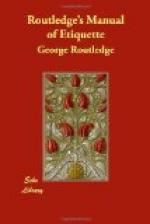No lady ought to be indifferent about her bonnet. It is to her face what the setting is to a jewel. The arrangement of the lace or blonde; the way it accords with the countenance; the harmony of colour with the rest of the dress, which in some instances it tones down by its quietness, and in others brightens and freshens by its contrast; all these are points to be considered. It is impossible not to be guided by fashion in the selection of a bonnet, and the same fashion will prescribe how it is to be trimmed, but, as a rule, we protest against beads and tinsel of all kinds. If beads must be used, they should be used sparingly. We saw a bonnet this year which was nothing but black beads, which were designated by the high-sounding name of “black pearls.” The bonnet was heavy, and very ugly; and when we remonstrated against it, we were assured it had just arrived from Paris—as if the announcement of such a fact was, in itself, enough to silence all objections. But it had no effect upon us, for the bonnet was objectionable on every ground—on account of its weight and appearance.
In London, as it is necessary to have a succession of bonnets, which soon become discoloured and spoilt by the soot and dirt of our great metropolis, all that really signifies is that they should look fresh and clean, and in harmony with the dresses with which they are worn; and therefore it is important they should be cheap. To give three guineas and even more, and perhaps five, for a bonnet which will last for only one month is an expensive proceeding; and when it is considered that really pretty bonnets can be bought for eighteen shillings, which look quite as well as those which are more costly, they are without excuse who do not manage to have always one nice-looking bonnet for special occasions.
We have known some ladies who are clever and wise enough to make their own bonnets, and then the cost of them is about five or six shillings each. If the lady’s maid is clever and handy, and knows how to make them, she will probably make them quite as well as any professed milliners. All that is required is to understand what fits and suits the person for whom the bonnet is intended. Every one finds that one shape suits her better than another. The next point in making a bonnet is that the “artiste” should have a light hand, and should make it “off-hand,” without letting it lie about to get soiled or tumbled. Things which are not expensive, but are made of common materials, should look fresh. If they have that merit, no one will examine them very closely to see whether the lace is real, or the flowers of the first quality. Satisfied with the general effect and style, no inquiries will be instituted into the cost of the materials. People are not so particular where their eye is pleased. On the contrary, where the effect is good, cheapness increases its value in the estimation of those who know that one and one make two.
No one can make bonnets, or indeed any kind of headgear, without one of those hideous figure-heads called “blocks,” upon which the bonnet or the cap is made, without risk of injury. This is the only way in which the milliner can form any idea of the effect of her handiwork. She can turn it about to get the full, side, and back view of her performance, without touching the article in question, which, if it is mauled about ever so little, soon loses its freshness.




